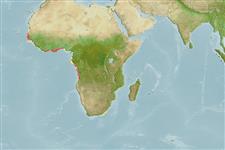Teleostei (teleosts) >
Gobiiformes (Gobies) >
Gobiidae (Gobies) > Gobiinae
Etymology: Thorogobius: Greek, thoros = semen + Latin, gobius = gudgeon (Ref. 45335); alvheimi: Named for Oddgeir Alvheim of the Institute of Marine Research, Bergen, Norway.
Eponymy: These genera and species are named after ‘Thor’, the first Danish research vessel specifically equipped for oceanic scientific research (named after the Norse god of thunder). [...] Oddgeir Berg Alvheim (d: 1944) of the Institute of Marine Research in Norway. [...] (Ref. 128868), visit book page.
Environment: milieu / climate zone / depth range / distribution range
Ecology
Marine; pelagic-neritic; depth range 74 - 208 m (Ref. 118185). Deep-water
Distribution
Countries | FAO areas | Ecosystems | Occurrences | Point map | Introductions | Faunafri
Eastern Atlantic: Angola and Ghana.
Size / Weight / Age
Maturity: Lm ? range ? - ? cm
Max length : 10.2 cm SL male/unsexed; (Ref. 118185); 7.2 cm SL (female)
Short description
Identification keys | Morphology | Morphometrics
Dorsal spines (total): 7; Dorsal soft rays (total): 11; Anal spines: 1; Anal soft rays: 10; Vertebrae: 28. This species is distinguished from its congeners by the following characters: D1 VI (second and third distinctly elongated), D2 I,11; pectoral fin rays 20-21; complete pelvic disc with short with well-developed anterior membrane (frenum), lateral lobes pointed; nape and predorsal area naked; no scales on the opercle; scales in longitudinal series 27-31; supratemporal rows tr and trp developed and extending transversally between pores H and K; longitudinal row g is short, not passing row m posteriorly and distinctly distant from row h; long infraorbital row 6, ventrally extending to lower margin of preopercle, its ventral section 6i originating anterior to its dorsal section 6s; posterior lateral row h reaching anteriorly above posterior third of opercle; body depth 16.6-20.4% at anal-fin origin in SL; head width 42.9-53.8% in head length; upper jaw long 42.6-45.7% in head length; minimum height of caudal peduncle 34.8-50.2% in caudal peduncle length; large eyes 22.4-31.3% in head length; short caudal fin 27.1-32.3% in SL; body is uniformly pale fawn and brown with margin of scale pockets dark brown pigmented, yielding a reticulated pattern; presence of pale spots on nape and predorsal area; caudal fin is uniformly dusky greyish (Ref. 118185).
Specimens were dredged on the outer edge of the continental shelf and found on soft bottom (Ref. 118185).
Life cycle and mating behavior
Maturity | Reproduction | Spawning | Eggs | Fecundity | Larvae
Sauberer, M., T. Iwamoto and H. Ahnelt, 2018. Two new deep-water species of the genus Thorogobius (Teleostei: Gobiidae) from the upper continental slope of the Eastern Central Atlantic. Zootaxa 4429(2):357-371. (Ref. 118185)
IUCN Red List Status (Ref. 130435: Version 2024-2)
Threat to humans
Harmless
Human uses
Tools
Special reports
Download XML
Internet sources
Estimates based on models
Phylogenetic diversity index (Ref.
82804): PD
50 = 0.5156 [Uniqueness, from 0.5 = low to 2.0 = high].
Bayesian length-weight: a=0.00724 (0.00339 - 0.01546), b=3.10 (2.92 - 3.28), in cm total length, based on LWR estimates for this (Sub)family-body shape (Ref.
93245).
Trophic level (Ref.
69278): 3.4 ±0.4 se; based on size and trophs of closest relatives
Resilience (Ref.
120179): High, minimum population doubling time less than 15 months (Preliminary K or Fecundity.).
Fishing Vulnerability (Ref.
59153): Low vulnerability (10 of 100).
